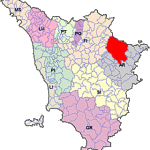Questo articolo è disponibile anche in:
![]() Français
Français ![]() Deutsch
Deutsch ![]() Español
Español ![]() Italiano
Italiano
Casentino is a valley crossed by the River Arno, here is the source of the most important river of Tuscany, set among the hills of Pratomagno and the Tosco-Romagnolo Apennine.
The territory covers approximately 800 square kilometers in the northern part of the province of Arezzo. It is bordered to the north by the Emilia-Romagna and to the west by the province of Florence.
Casentino is in fact the upper valley of the Arno River, a green amphitheater closed in the mountains, rich in forests and isolated by the mountains that protect it, this land is partly remained the simple atmosphere that characterized the rest of Tuscany of the past decades.
The mountains of the Tosco-Romagnolo Apennine delimit the area to the north, in this area there are the Mount Falterona (1,654 meters) and Mount Falco (1,658 meters).
THE SOURCES OF THE ARNO RIVER
On Mount Falterona is the source of the Arno River, this river flows along the Casentino territory and shapes and characterizes the territory. To the west rises the massif of Pratomagno (1,592 meters). The Upper Tiber Valley (Alta Val Tiberina) is separated from the mountains of Casentino by the Alpe di Serra and the Alpe di Catenaia.
The area is rich in natural and artistic beauty, rich in forests of beech and fir (much of the Apennine area is part of the National Park of Casentino Forests, Mount Falterona and Campigna). There are also monastic complex surrounded by greenery (La Verna, Camaldoli) and ancient castles (Poppi, Romena), Casentino is now an important tourist destination of Tuscany.
This region is an area for nature and tranquility lovers, but also for those in search of art and mysticism in solitary hermitages of Camaldoli and Verna. The topography of the area is particularly varied, there are plains and mountains full of great forests, its nature as an isolated valley surrounded by mountains has preserved the traditions of the people who inhabit it. Casentino is also a land of towns and villages quiet and isolated rich in art and history.

Autumn is probably the best season to visit the area, in this period, in fact the woods – sometimes shrouded by clouds and fog – light up with incredible colors ranging from red to yellow, making the landscape really spectacular.
BIBLIOGRAPHY
- AA. VV. “Guida ai prodotti agroalimentari del Casentino. Itinerari tra cultura e tradizioni locali” Unione Comuni Montani del Casentino, 2012
- AA. VV. “Toscana” Guide Rosse Touring Club Italiano, 2007
- Rombai Leonardo; Stopani Renato “Il Casentino. Territorio, storia e viaggi” Polistampa, 2012
Questo articolo è disponibile anche in:
![]() Français
Français ![]() Deutsch
Deutsch ![]() Español
Español ![]() Italiano
Italiano
